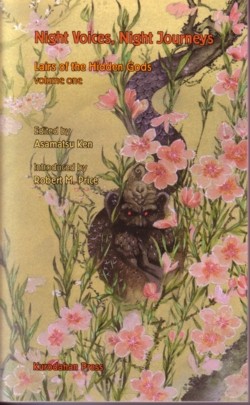Night Voices, Night Journeys
Originally for Raw, New Things #16, 5/1/2005

But one very special type of outstanding story, after silencing the reader, stimulates them into furious action. I'm sure you know what I'm talking about.
–Asamatsu Ken, from his introduction
Night Voices, Night Journeys is the first volume of a projected four-book series that translates two fat volumes of indigenous Lovecraftian stories from Japan. Volume 2, Inverted Kingdom has been announced for the end of 2005. Many of the authors represented herein are apparently well-known authors in Japan. There is a certain seriousness to this collection that is often lacking in books of Lovecraftian pastiches published in English. No sly in-jokes, no little winks at the audience, waiting for them to get the reference. A seriousness and a freshness of setting pervade this book, so it does achieve what so many anthologies set out to be; different, and yet in some way tied into Lovecraft. The stories are also, on average, longer than the stories found in a American anthologies, only seven stories are told in 287 pages.
"The Plague of St. James Infirmary" is the longest story in the collection at over a hundred pages, and details events happening to a Japanese man in Chicago during the early Prohibition era. Of all the stories presented, this one had the most stilted prose, and I'm not sure if this is due to the translation or the prose style of the author. Despite the decidedly Derlethian leanings of the story (the power of Cthulgha is set against the water deity Cthaat), it creates a fairly good sense of atmosphere.
"The Import of Tremors" is a slow, graceful story that opens as Kobe City is being firebombed during World War II. One of two stories that deal explicitly with the war, this takes the form of an older man reminiscing about his childhood, effectively setting otherworldly horrors off against the more mundane horrors of the period.
"27 May, 1945" also takes place during World War II, this time on the island of Okinawa as the Americans are assaulting the island. What feels, early on, like it could be a metaphor of the Americans as demonic/otherworldly invaders ultimately turns out to be significantly more complex, and does not draw on any such simple, straightforward metaphor.
"Night Voices Night Journeys" is perhaps the weakest story of the collection, relying on a ‘surprise' tactic that is only somewhat effective, rendering the story significantly less interesting on subsequent readings. It is almost a prose poem more than a story, beautifully painting the city of Shanghai and its underworld.
"Sacrifice" is the curious, almost Shirley Jackson-esque tale of some city folk who move out to the country, and encounter a strange farming community there. Told from the point of view of a husband who commutes from the country into the city every day, he watches as his stay-at-home wife encounters an unusual commune of organic farmers. He looks on helplessly as she is drawn further and further into their strange ideology. The conclusion is very interesting–it appears that the story has gone one way, but a small epilogue suggests a different interpretation.
"Necrophallus" is the most distinctly modern story, and certainly the most graphic. I could not help thinking as I read this story that this is what the stories from Horror Between the Sheets with they were. The author, Mikano Osamu, controls this story with a deft hand, slowly revealing more of the narrator's secrets, keeping the reader's appetite whet for more. It is only after he has been exposed for what he is that the greater horror comes. "Necrophallus" is also the most unabashedly grisly of the stories presented.
"Love for Who Speaks" uses the Mythos as a metaphor for social commentary, and almost manages not to make the commentary a burden to the story. Told from the perspective of a woman named Chisa during her engagement and subsequent marriage to Izutsu Masaaki, her story turns strange when she conceives a longing to see the ocean. If the story is a bit heavy-handed in its metaphor, it's still quite worth reading.
The final fifty or so pages are a bibliography of Lovecraft and Lovecraft-derived work that has appeared in print in Japan, both as illustrated manga and in purely textual stories. The lists are dizzying and vast, but unfortunately does not include a list of the work that has been translated into English.
My one complaint with this book is that editor Robert Price insists on putting spoilers into his introduction/analysis of the stories. This necessitates, in order to get the full effect of the story, reading the story and then returning to the commentary, which strikes me as an unnecessary convoluted way to read short stories. Beyond that, small complaint, and the occasional nitpick of various stories, this is a very strong anthology which was a great pleasure to read. The fusion of the familiar (Lovecraftian tropes) with the alien (Japanese culture) gives new vigor to the Lovecraftian elements to the stories. Viewed from a different perspective, the old wonders and fears are again novel. .